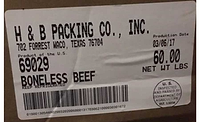Beef processor steps up E. coli testing to serotypes

“BPI has always been an industry leader in our commitment to ensuring food safety and quality in our beef,” says Craig Letch, BPI’s director of quality assurance. “BPI led the hold-and-test initiative and has applied its own rigorous program for more than 15 years, and we are now expanding our testing even further to include testing for these other potentially harmful bacteria.”
While most common E. coli are not pathogenic, Shiga-toxin-producing E. coli (STEC) pathogens, collectively referred to as non-O157 STECs, are forms of E. coli that are capable of producing negative health effects similar to those caused by E. coli O157:H7, which is the most widely known strain to raise serious health concerns in the US.
“Our goal is to provide the safest and highest-quality beef. Using newly available testing methods, we are able to add tests for these additional STECs beyond O157:H7, which will help us further ensure the safety and quality of our lean beef and that consumers are better protected from potential exposure to these harmful pathogens,” Letch adds.
The USDA, through its Food Safety Inspection Service (FSIS) declared E. coli O157:H7 an adulterant in ground beef in 1994. Any raw ground beef sampled and tested that contains this pathogen cannot be sold for human consumption in an uncooked form. USDA and beef industry initiatives since that time have been effective in reducing the prevalence of this pathogen from the beef supply. Still, recent global health concerns caused by E. coli pathogens other than O157:H7 and in foods other than beef highlight the value of expanding testing to include these six and other pathogens.
“With the test methods still developing for these six strains, the recent situation in Europe convinced us that it was time to add tests for these other potentially harmful pathogens now,” says Letch. “While this additional testing will add significantly to the cost of BPI’s current hold-and-test program, our decision to voluntarily start this testing is consistent with our overall commitment to food safety and quality.”Looking for a reprint of this article?
From high-res PDFs to custom plaques, order your copy today!




